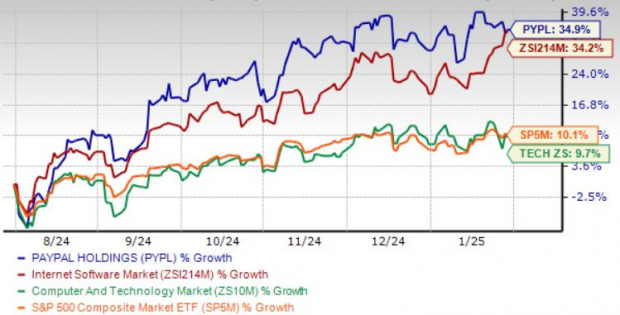PayPal Stock Surges: Key Performance Highlights and Investor Insights
PayPal (PYPL) shares have returned 35% over the past six months, outperforming the Zacks Computer and Technology sector, which returned 9.7%, and the Zacks Internet Software industry, which appreciated 34.2% during the same period.
Strong Portfolio Drives PayPal’s Success
PayPal’s robust business model helps it maintain strong and trusted relationships with both merchants and consumers. By using a two-sided platform, the company fosters strong financial connections between customers and merchants.
This strategy contributed to a notable increase in total payment volume, which rose 9% year over year, resulting in $422.641 billion in the third quarter of 2024, regardless of currency rate changes.
PYPL Stock’s Performance

Image Source: Zacks Investment Research
In addition, active accounts increased by 1% to a total of 432 million, with payment transactions per account reaching 61.4 million, a 9% year-over-year rise.
The transaction margin grew significantly, totaling $3.7 billion, which is an increase of over 8% on a reported basis. This growth is attributed to improved interest income and services like branded checkout, Venmo, Braintree, and tech-led risk/loss enhancements.
PayPal also saw a 15% to 20% rise in Buy Now, Pay Later usage in the last quarter. Looking ahead to 2025, the company aims to attract more traffic by quickly launching new product experiences like mobile checkout for merchants.
Valuation Advantage of PayPal Stock
Despite its recent success, PYPL presents a value opportunity, reflected by its Value Score of B. Currently, the stock trades at a forward 12-month price-to-earnings (P/E) ratio of 17.91, notably lower than the industry average of 38.64.
PYPL’s P/E Ratio (F12M)

Image Source: Zacks Investment Research
Additionally, PayPal shares are trading above both the 50-day and 200-day moving averages, suggesting a positive market trend.
PYPL Stock Trends Above 50-Day & 200-Day SMA

Image Source: Zacks Investment Research
Innovation as a Catalyst for Growth
Innovation plays a crucial role in PayPal’s growth. The company recently launched Fastlane, which streamlines the checkout process by enabling customers to complete purchases in one click. Since August, over 1,000 merchants have adopted Fastlane, enhancing customer experiences and improving conversion rates. This feature leverages PayPal’s extensive payment expertise and is now available to approximately 170 million eligible users in the U.S.
Expanding its reach, PayPal is introducing PayPal Complete Payments in regions like China and Hong Kong, aiming to serve more small and medium-sized businesses (SMBs) in the coming years.
Growing Partnerships Enhance PayPal’s Reach
PayPal’s collaborations with companies like Fiserv, Adyen, Amazon (AMZN), Global Payments, and Shopify (SHOP) enhance its market potential. The integration of PayPal into Shopify Payments in the U.S. is designed to provide a more efficient operational experience for business owners.
With its partnership with Amazon, PayPal now offers Checkout options for SMBs using Buy with Prime. In 2025, Prime members will be able to link their PayPal accounts to receive shipping benefits while shopping.
The integration of the Venmo debit card with Apple Pay and Google Pay through collaborations with these tech giants has also been significant. Since launching PayPal Everywhere, the company has attracted over one million first-time debit card users, with plans to expand this initiative to Europe next year.
Globally, PayPal remains a favorite payment method for users across Meta Platforms (META), and it supports transactions for creators and developers through Hyperwallet, while Braintree facilitates credit card processing for META.
Upward Earnings Estimates Signal Potential
Recent trends show a positive outlook for PayPal, with 2025 earnings estimates now at $4.91 per share, reflecting an uptick of one cent over the last month. This indicates an expected growth of 7.13% compared to the 2024 estimate of $4.58. Moreover, anticipated revenues for 2025 stand at $33.07 billion—a 4.46% increase over the 2024 estimate of $31.66 billion.
For the last four quarters, PayPal has consistently surpassed earnings expectations, realizing an average surprise of 15.14%.
PayPal Holdings, Inc. Price and Consensus

PayPal Holdings, Inc. price-consensus-chart | PayPal Holdings, Inc. Quote
With PayPal’s solid portfolio, expanding partnerships, and attractive valuation, the stock appears inviting for long-term investors. Existing shareholders might find the company’s future growth potential promising.
However, there are concerns about decreased volume and revenue growth throughout the fourth quarter of 2024 and into 2025, particularly with Braintree products. Enhanced marketing expenditures may also increase non-transaction operating costs, which are expected to rise in the low-single-digit range for 2024 and continue into 2025.
Given these factors, a cautious approach to PYPL shares may be wise, and potential investors may benefit from waiting for a better entry point. Currently, PayPal holds a Zacks Rank #3 (Hold).
5 Stocks Poised for Doubling
Each stock featured has been selected by a Zacks expert as having the potential to gain +100% or more in 2024. While not all selections will yield positive results, past recommendations have seen remarkable returns of +143.0%, +175.9%, +498.3%, and +673.0%.
The majority of stocks in this report are largely unnoticed by Wall Street, making this an ideal opportunity for early investment.
Discover These 5 Potential Success Stories >>
For the latest stock recommendations from Zacks Investment Research, you can download the “7 Best Stocks for the Next 30 Days” report for free.
Amazon.com, Inc. (AMZN) : Free Stock Analysis Report
PayPal Holdings, Inc. (PYPL) : Free Stock Analysis Report
Shopify Inc. (SHOP) : Free Stock Analysis Report
Meta Platforms, Inc. (META) : Free Stock Analysis Report
To read this article on Zacks.com click here.
Zacks Investment Research
The views and opinions expressed herein are the views and opinions of the author and do not necessarily reflect those of Nasdaq, Inc.

